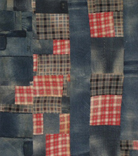 |
| Worn from his labor on the farm, Susana’s husband Julius’ denim overalls and flannel shirts were “recycled” into this striking quilt. The backing is pieced from mule feed sacks. ID.2006.79.22 |
|
Susana's quilts are pieced in a design-as-you-go improvisational style found among both blacks and whites in poorer, more isolated pockets of the rural South. People living in these more remote areas had less access to quilt pattern ideas published in newspapers or printed in books. For fabrics, rural women depended on mail order catalogs or whatever was available in the local store. These "constraints" left quiltmakers like Susana Hunter free to use their imaginations.
Making an improvisational quilt top required a continual stream of creativity during the entire process, as the quiltmaker made hundreds of design decisions on the fly, fashioning an attractive whole out of whatever materials were at hand. Overall visual impact mattered most—not minor details such as whether a patch in a row had a square or rectangular shape. Size and shape was determined by the scraps available at the time.
Creative recycling such as this was not only a means of survival. For many rural quilters, it was also a matter of pride to be able to "make something pretty out of nothing." Represented in the fabrics that make up Susana Hunter's quilts are work clothes worn from the family's toil in the fields, sacks from the cotton seed they planted each spring, scraps from the clothes Susana sewed for her family, and bulk sugar sacks from the food staples the Hunters bought in bulk at the local general store.
For Susana and her husband Julius, life often meant hard work and few resources. The Hunters were tenant farmers who grew cotton and corn, tended a vegetable garden, and raised hogs, chicken and cattle. They lived in a simple, two-room house that had no running water, electricity or central heat. The outside world came to them through a battery-powered radio and a wind-up phonograph. Though the Hunters didn't have much in the way of material goods or the latest 20th century technology, they never went hungry, raising much of their own food.
Susana's quilts warmed her family during chilly Alabama winters in the inadequately heated home. They added splashes of color to the unadorned living space—a cheerful kaleidoscope of vivid pattern and design against newspaper-covered walls. Susana very rarely bought new fabric for her quilts, she used what was at hand. Yet the lack of materials didn't restrict this resourceful quilter's creativity. Susana Hunter could cast her artistic eye over her pile of worn clothing, dress scraps, and left-over feed and fertilizer sacks—and envision her next quilt.
| |
-- Jeanine Head Miller, Curator of Domestic Life |
|

